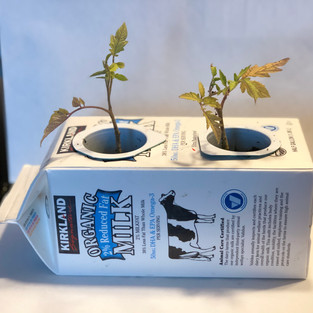How I Designed the Bottle Hydroponics System
- jwu102938
- Aug 13, 2020
- 4 min read
Updated: Aug 31, 2020
In late March, I started my own outdoor garden (you can read this blog post if you want to find out more). As I grew more and more plants, I realized that there wasn't enough space around my house anymore. My parents weren't too happy with the idea of digging a hole in our lawn, so I started using recycled plastic containers that used to house cookies or frozen foods and cardboard boxes.
Eventually, overcrowding led to stunted growth and yellowed leaves in some plants (like the corn shown below). As the days grew shorter and the temperatures started dropping, I felt a twinge of sadness. Gardening had been such a fun experience and being able to go outside every day and interact with nature had been almost therapeutic. I wondered if there was a better way to garden that saved space, grew healthier plants, and could be moved indoors.
I remember being in fifth grade and doing research on Styrofoam recycling. I was introduced to hydroponic farming because many hydroponic farms use Styrofoam to support floating plants. Marveling at the large, industrial hydroponic farms and studying their futuristic techniques really sparked a passion for building things with my hands and biology. I set hydroponic farming upon a pedestal and believed that incredibly smart people could only understand it.
It wasn't until I started my own garden that I remembered hydroponics and all of the positive, intellectual, unattainable associations I had attached to it. Naturally, that meant I was going to try my best to understand it and recreate one in my own backyard. I treated it as a challenge, and was excited to find a way to solve it.
I did hours of research on hydroponics, trying to understand how they worked and why they were considered a great alternative to traditional farming. You can check out the four manuals posted to the We Can Plant! webpage if you want to check out what I learned online.
I drew blueprints (thanks Applied Engineering!) of complicated hydroponic systems, made with 2 by 4s, PVC pipes, irrigation tubing, filters, and pumps. I tried to find stores that sold these materials for lower prices, but the price usually came to around $170, not to mention the electricity costs from running the pumps 24/7. I also felt uncomfortable buying so many plastic materials for something as natural as gardening. I felt discouraged and put the project away for a few weeks to work on other things.
It wasn't until I saw "A Cheap Alternative to RockWool [sic] and Net Cups" that my creativity and problem-solving was renewed. I realized that as long as I boiled down the components of a hydroponic system, I could find other ways to achieve the same purpose. Here is the list I came up with:
o A liquid nutrient medium
o A container to hold the nutrient medium
o Smaller containers to support the plants themselves
o A material to help hold the plants upright

After boiling hydroponics down into these four simple components, the rest was easy. I realized that many objects I typically threw away or recycled could be used to make a hydroponics system and that dirt could replace expensive rock wool or expanded clay pebbles used to hold the plants upright. I purchased hydroponics nutrients on Amazon and started collecting used milk cartons and yogurt containers.
As an experiment, I tried transplanting two yellowed, small tomato plants into the hydroponic system I had built and adding some nutrient medium, just to see if it would work. I took pictures of the plants before and after one week, and the results were shown below (the first two photos). Just to compare, I had transplanted another tomato plant about the same size into soil, and this is what it looks like one week later (the third photo).
Honestly, I was shocked by how quickly the tomato plants had grown in just one week because of hydroponics, and how big the difference was between photos 2 & 3 in just one week when they started at similar places. The yellow/brown leaves even turned a deep, healthy shade of green! I have really high hopes for lettuce, spinach, and other plants even better adapted to hydroponics.
I had already grown lettuce plants outside, and several of them had produced seed pods (shown below). Lettuce is known for being easier to grow indoors, especially during the winter, and is the right size for a hydroponic system. I collected the seed pods, gently removed the seeds, and replanted them inside four ramen takeout containers, an almond-milk carton, and a Milano cookie container. Two days later, many of the seeds had already sprouted!
I'll keep you guys posted! Hydroponics is a great way for everyone to grow their own food all year, and recycled materials can dramatically decrease its cost. Click here to learn how to make one!
If you have any questions or suggestions, you can reach out to us at troyyouthef@gmail.com. We're looking forward to it!

































Comments